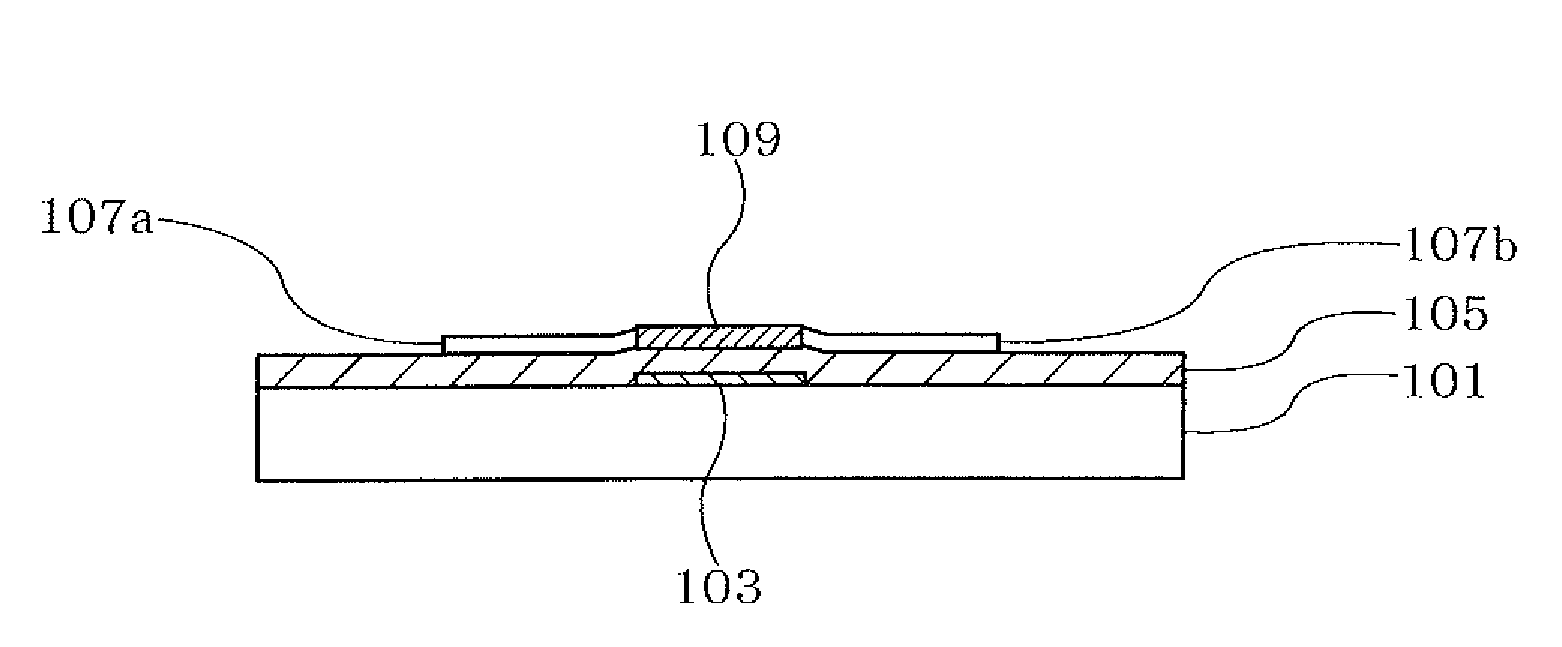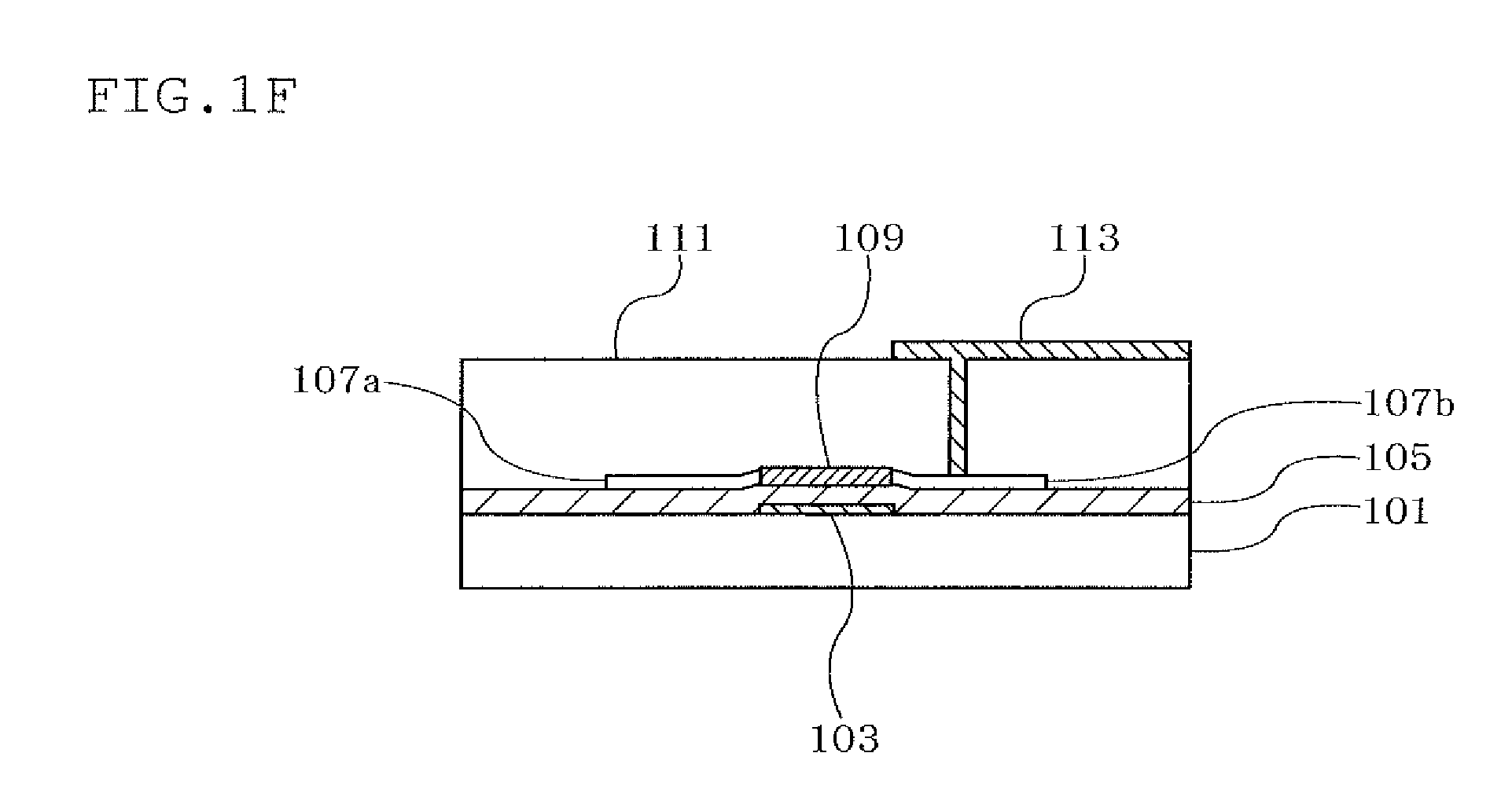Field effect transistor, semiconductor device and semiconductor device manufacturing method
a field effect transistor and semiconductor technology, applied in semiconductor/solid-state device manufacturing, semiconductor devices, electrical equipment, etc., can solve the problems of uneven display in a display, overlapping of gate electrodes and source/drain electrodes, and slow circuit operation, so as to improve interfacial strength, reduce contact resistance, and improve the effect of interfacial strength
- Summary
- Abstract
- Description
- Claims
- Application Information
AI Technical Summary
Benefits of technology
Problems solved by technology
Method used
Image
Examples
embodiment 1
[Bottom-Gate Type Self-Aligned Transistor]
[0166]In this embodiment, by heating the gate electrode, a part of the conductive amorphous oxide film which overlaps the gate electrode is allowed to be semiconductive (crystallized) to form a semiconductor layer. A part which does not overlap the gate electrode retains its conductivity and becomes the source / drain electrodes. As a result, a self-aligned field effect transistor can be formed. The semiconductor layer and the source / drain electrodes have the same composition.
[0167]FIGS. 1A to F each show a step of the method for producing a transistor of Embodiment 1.
(1) Substrate
[0168]A substrate 101 provided with an undercoating film (not shown) is prepared (FIG. 1A).
[0169]As the undercoating film, a single layer of an insulating layer such as a silicon oxide film, a silicon nitride film, a silicon oxynitride film (SiOxNy) (x>y), a silicon nitroxide film (SiNxOy) (x>y) or the like or a stack of these films can be used. The undercoating film...
embodiment 2
[Bottom-Gate Type Self-Aligned Transistor]
[0196]This embodiment differs from Embodiment 1 in that the transistor having the same shape as that of Embodiment 1 is produced by photolithography using the gate electrode as a mask. In this embodiment, the gate electrode is not heated. Also in this embodiment, the semiconductor layer and the source / drain electrodes have the same composition.
[0197]FIGS. 2A to 2E each show a step of the method for producing a transistor of Embodiment 2.
[0198]In the same manner as in Embodiment 1, on a substrate 201, a gate electrode 203, a gate insulating film 205 and an amorphous oxide film 207 are formed (FIG. 2A). Further, a resist 215 is applied (FIG. 2B). Subsequently, using a gate electrode 203 as a mask, light is irradiated from below the gate electrode 203, and the resist 215 is developed and removed, whereby the part above the gate electrode 203 is opened (FIG. 2C).
[0199]Subsequently, an amorphous oxide film 207 in the opening of the resist 201 is ...
embodiment 3
[Bottom-Gate Type Self-Aligned Transistor]
[0201]In this embodiment, a transistor is formed by a lift off process by using a gate electrode as a mask.
[0202]FIGS. 3A to F are each a view showing a step of the method for producing a transistor of Embodiment 3.
[0203]As in the case of Embodiment 1, on a substrate 301, a gate electrode 303, a gate insulating film 305 and an amorphous oxide film 307 are formed (FIG. 3A). Subsequently, the amorphous oxide film 307 is allowed to be semiconductive (crystallized) 309 (FIG. 3B). Allowing the amorphous oxide film to be semiconductive can be conducted by annealing by means of an electric furnace or the like. The relationship between the temperature and the time during the annealing is shown in FIG. 10. Based on this relationship, an appropriate treatment temperature and an appropriate treatment time can be selected. Thereafter, a resist 315 is applied, and using the gate electrode 303 as a mask, light is irradiated from below the gate electrode 3...
PUM
 Login to View More
Login to View More Abstract
Description
Claims
Application Information
 Login to View More
Login to View More - R&D
- Intellectual Property
- Life Sciences
- Materials
- Tech Scout
- Unparalleled Data Quality
- Higher Quality Content
- 60% Fewer Hallucinations
Browse by: Latest US Patents, China's latest patents, Technical Efficacy Thesaurus, Application Domain, Technology Topic, Popular Technical Reports.
© 2025 PatSnap. All rights reserved.Legal|Privacy policy|Modern Slavery Act Transparency Statement|Sitemap|About US| Contact US: help@patsnap.com



